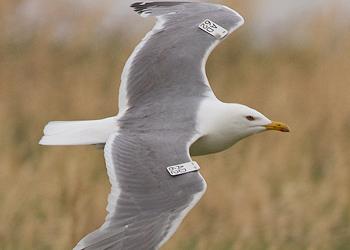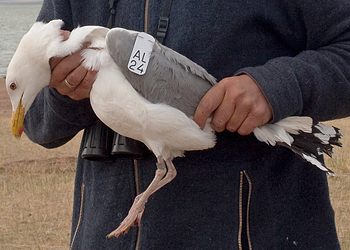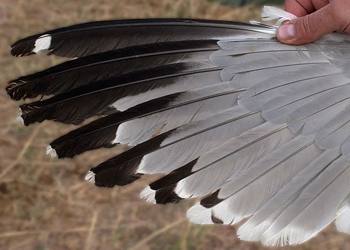 Larus cachinnans
Larus cachinnans
(last update:
Greg Neubauer
Marcin Przymencki
Albert de Jong
Mars Muusse
3cy cachinnans: February
Phenotypic variation and systematics of Mongolian Gull
IN: Dutch Birding 23: 82, 2001 BY: Pierre Yésou
PART 1: INTRO & DISTRIBUTION
BELOW: PART 2 PHENOTYPIC VARIATION
Phenotypic variation
The original description of mongolicus by Sushkin (1925) is as follows: ’Above as vegae [Vega Gull L. vegae], darker than cachinnans ([from] Kirghiz steppe and Lake Zaissan), feet pink, orbital ring vermilion-red; grey wedges of the inner webs of primaries shorter and darker than in cachinnans but lighter than in vegae. Wing male 462-480, female 442-450, tarsus 65-70, middle toe 52-38. From 8 specimens, South-Eastern Altai and NW Mongolia. Type: male ad., 9.VII.1914, Lake Uring-noor, NW Mongolia' (Sushkin’s descriptions of new taxa are both in Russian and English).
Further details were given by Stegmann (1934). He studied 27 skins of adult birds and mentioned a wing-tip pattern darker than in cachinnans and closer to Birula Gull L. v. birulai, with black on the seven or eight outermost primaries and a subterminal black bar on p10 (primaries are numbered ascendently). The latter taxon was given the name birulai (Pleske 1928), in honour of the great sailor and Arctic explorer Birula, hence the male gender. Regrettably, many authors kept using the name ’birulae’, a misspelling by Stegmann (1934). Birulai is hardly differentiated from vegae, except for the variable leg colour and darker iris in some birds. It is treated as either a synonym of vegae or a subspecies of it (eg, Stepanyan 1990, Kennerley et al 1995, Yésou & Hirschfeld 1997, Panov & Monzikov 2000).
Thereafter, information on the phenotype of mongolicus remained scanty for a long time. Dement’ev (1951), in his review of the gulls of the USSR, simply stated that the plumage is similar to that of vegae and summarized Stegrnann’s (1934) description of the wing pattern. The most recent Russian systematic review (Stepanyan 1990) was even more anecdotal: ‘mantle colour a little darker than in cachinnans, leg colour varying from pink-grey to yellow’. In his review of the variation of the Palearctic large white-headed gulls, Devillers (1983) simply mentioned a mantle similar to or darker than that of Yellow-legged Gull L. michahellis, with more black on the primaries.
Then, western pioneers began to visit the breeding grounds of mongolicus, in particular Steve Madge. He described the iris as ’definitively’ dark (Madge 1983), before acknowledging that the iris in fact varies from almost white to very dark (Madge 1985). Also, he found the legs to be fleshy-pink in most adult birds (Madge 1985). Grant (1986) mentioned that birds seen in Mongolia were pink legged, some yellowish legged, and seemed to have a dark iris. Lastly, Pyzhianov & Tupitchyn (1992) published a short article, unfortunately hardly accessible to western gull students, that is the most detailed publication on the phenotypic variation of mongolicus to date. They mostly focused on leg colour which varied from pink to yellow and orange, none of these colours occurring in more than half of the adult birds at any of their study plots. Further articles on Asian gulls (eg, Kennerley et al 1995, Yésou & Hirschfeld 1997) were no more informative, with the exception of Panov & Monzikov (2000) who gave information on the wing-tip pattern of mongolicus.
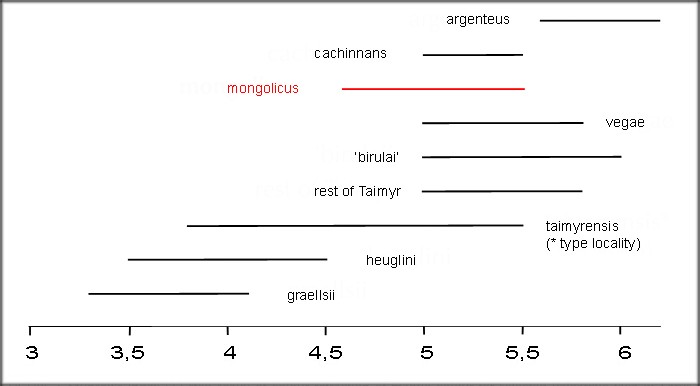
FIGURE I Munsell’s index (37-step scale) of colour refraction of mantle colour for selected Palearctic taxa of Larus argentatus-cachinnans-fuscus complex. Darkness of grey mantle decreases from left to right. Only specimens of range given in type description, ie, lower reaches of Yenisei river in south-western Taimyr, have been included in Taimyr Gull L. (heuglini) taimyrensis. Specimens used for Birula Gull L. vegae birulai came from western Yakutia and east to Kolyma delta, those for Vega Gull L. vegae from east of Kolyma river to Chukchi peninsula. Argenteus, not representing a valid subspecies according to Dutch committee for avian systematics (CSNA) (Sangster et al 1999), refers to western and paler population of Herring Gull L. argentatus. Data from Barth (1966) and by courtesy of Andrey Filchagov (in litt) and Sergey Pyzhianov (in litt).
| TABLE 1 Measurements (mm) of 42 adult (unsexed) Mongolian Gulls Larus (cachinnans) mongolicus trapped at nests at Lake Baikal, Siberia, Russia, on 2-26 June 1992. Two different measurements of tarsus were taken: I from centre of both joints as usually done on skins (’museum’); and 2 from outer extremity of both articulations which is most convenient way when measuring live birds (’field'). | ||
| . | Range | Mean ± SD |
| Culmen | 48.0-61.7 | 54.9 ± 3.0 |
| Gonys height | 16.6-22.0 | 19.0 ± 1.4 |
| Head plus bill length | 115-139 | 126.3 ± 6.1 |
| Tarsus (museum) | 63.2-79.3 | 68,9 ± 3.2 |
| Tarsus (field) | 67.8-87.8 | 80.5 ± 3.9 |
| Folded wing | 432-494 | 458.5 ± 14.8 |
Results
Overall appearance
Mongolicus is a large and heavy gull, with a mean weight of 1140 g at the time of incubation (880- 1580 g, n = 11, unsexed). The wingspan, calculated from freshly dead birds (positioned as live birds), is 140-160 cm (with four females ranging from 138 to 146 cm and five males from 146 to 156 cm). Further measurements are given in table 1.
It is a large-chested, broad-necked and large-billed bird. The bulky appearance is partly tempered as the birds often stand rather upright on their long legs while the long wings give them an attenuated rear body.
The mantle is mid-grey, with MuseIl’s index of colour refraction ranging from 4.5 to 5.5 in 32 birds of Lake Baikal (Sergey Pyzhianov pers comm). This means that mongolicus is distinctly paler than heuglini, the mantle colour of many birds matching that of cachinnans as well as that of many vegae (including birulai) and taimyrensis (figure 1).
The wing-tip is among the darkest of the Asian taxa: usually seven (ranging from six to nine) outer primaries show black, sometimes extending onto the outermost coverts. There are two white mirrors, less often only one. Large white scapular and tertial crescents (13-27 and 19-42 mm wide, respectively, in 44 birds) are shown on the folded wing. The rest of the plumage is white, except for the pale grey underwing.
In contrast to the well-marked winter plumage of vegae and birds of Taimyr, mongolicus only shows poorly developed dark streaks on the head after the post-breeding moult (Dement’ev 1951). Birds still present at Lake Baikal in November show a virtually all-white head and neck (Sergey Pyzhianov pers comm).
The bill is yellow with a red gonydeal spot and shows variable dark markings. The iris varies from yellowish-white to dark grey-brown and the legs from pale flesh to bright orange. All these variations, and those in the wing-tip pattern, will be detailed in the next paragraphs.
| TABLE 2 Number of black-tipped primaries in Mongolian Larus (cachinnans) mongolicus, Vega L. vegae and Baraba Gulls L. (c.) barabensis. Data on barabensis and vegae from Panov & Monzikov (2000) and from skins at Zoological Institute of St Petersburg, Russia, respectively. Remarks: a= Number of black-tipped primaries can differ by one, thus bird showing, for instance, eight black-tipped primaries in one wing and nine black-tipped primaries in other wing is scored 8.5. b= Vegae includes Birula Gull L. v. birulai but no birds of Taimyr have been considered in sample. c= Panov & Monzikov (2000) did not look for asymmetry in number of black-tipped primaries. Also, their small sample did not include any specimen with nine black-tipped primaries; however, such birds do occur (Yésou & Hirschfeld 1997). |
|||
| Number of black-tipped primaries | mongolicus (%) |
vegae b (%) |
barabensis (%) |
| 8.5 a | 1 |
- |
- c |
| 8.0 | 11 |
- |
39 |
| 7.5 a | 8 |
- |
- |
| 7.0 | 74 |
36 |
39 |
| 6.5 a | - |
10 |
1 |
| 6.0 | 6 |
42 |
22 |
| 5.5 a | - |
4 |
- |
| 5.0 | - |
8 |
- |
| Sample (n) | 89 |
50 |
18 |
Wing-tip pattern
According to a study of 89 adult-plumaged birds in the hand in colonies at Lake Baikal (an examination of museum skins did not result in additional information), at least some black occurs on the six (P5-P10) to nine outermost primaries (P2-P10), most often on the seven outermost ones (P4-P10), with a different number of black-tipped primaries in the two wings in c 10% of the birds (table 2). The black extends onto some or all outermost primary-coverts in 25 out of 84 birds with black on at least seven outer primaries. Such an extension of black onto the outer coverts (which otherwise always have a black shaft) was not observed in birds with only six black-tipped primaries. This could, however, be explained by the sample size. The proportion of adult birds with at least some black markings on the outer coverts is c 30%. Due to both the number of black-tipped primaries and the frequency of black on the coverts, the wing-tip of mongolicus is among the darkest of the Asian taxa of the argentatus-cachinnans-fuscus complex, averaging darker than in vegae. Only barabensis more frequently shows black on eight primaries (table 2).
 |
Figure 8. Extent of black in the primaries of a sample of vegae and mongolicus. Source Surfbirds: IDENTIFICATION OF ADULT VEGA GULL: FIELD OBSERVATIONS FROM JAPAN, FEBRUARY 2003 by Chris Gibbins. |
The tongue on the inner web of the outermost primary (P10) is pale grey. It is usually rather long, ending 9-15 cm from the primary-tip (see also Panov & Monzikov 2000) and covering about two-thirds of the width of the inner web. It is, however, shorter (ending up to 20 cm from the primary-tip) and narrower and somewhat darker in some birds, particularly those with eight or nine primaries with black, then resembling the usual vegae and birulai pattern. In such birds, the pale tongue can be less distinctly delineated from the black inner part of the web, being suffused with blackish.
White mirrors usually occur on both P9 and P10 but seven out of 67 (10%) adult-plumaged birds examined showed only a white mirror on p10. The white mirror on P10 invariably forms a complete band covering the full width of both webs. It is usually separated from the white wingtip by a subterminal black bar of 5-25 mm width although this bar was absent in two birds and incomplete in four others. The subterminal black bar was thus lacking, at least in part, in 9% of the handled birds. By way of comparison, this bar was incomplete or absent in 13 out of 45 (29%) skins of vegae and birulai, and it is usually absent in cachinnans (eg, Garner & Quinn 1997, Panov & Monzikov 2000). The length (measured along the feather-shaft) of the white mirror on P10 varied from 19 to 47 mm (with a mean of 36,4 mm), being 34-40 mm in half of the sample. It was worn at the tip and 48 and 55 mm long, respectively, in the two birds without a subterminal black bar. The white mirror on P9 extends onto both webs (68% of 60 birds with a white mirror on P9) or is limited to the inner web (32%), exceptionally to the outer web (one case was mentioned by Panov & Monzikov 2000, ie, 1% of 92 birds, pooling their and mine samples). It forms either a complete white band (nine birds, 15%) or more often one or two white spots of variable pattern: white on both webs, extending to the border of the inner web (28%); white on both webs, fully surrounded with black (25%); white on the inner web only, extending to the border of the web (12%); white on the inner web only, fully surrounded with black (20%). The maximum length of the white mirror on P9 (measured parallel to the feather-shaft) varied from 6 to 31 mm (with a mean of 17.7 mm), being 10-22 mm in 77% of the cases. No strong statistical relationship was found between the respective sizes of the white mirrors on P9 and P10 (n = 60).
END OF PART 2
 Larus cachinnans 3CY PDHC February 19 2012, Zagreb, Croatia. Picture: Ruud Altenburg.
Larus cachinnans 3CY PDHC February 19 2012, Zagreb, Croatia. Picture: Ruud Altenburg.  Larus cachinnans 3CY PDTX February 19 2012, Zagreb, Croatia. Picture: Chris Gibbins.
Larus cachinnans 3CY PDTX February 19 2012, Zagreb, Croatia. Picture: Chris Gibbins.  Larus cachinnans 2CY & 3CY PKAD January 2012 & February 2013, Lake of Constance - Steinach, Switzerland.
Larus cachinnans 2CY & 3CY PKAD January 2012 & February 2013, Lake of Constance - Steinach, Switzerland.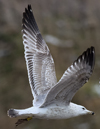 Larus cachinnans 2CY-3CY PKBB October 2012 & February 2013, Germany & the Netherlands. Picture: Armin Deutsch & Maarten van Kleinwee.
Larus cachinnans 2CY-3CY PKBB October 2012 & February 2013, Germany & the Netherlands. Picture: Armin Deutsch & Maarten van Kleinwee. Larus cachinnans 1CY-2CY PLVE December 2012 - November 2015, Utrecht & Amsterdam, Noordzee, Terschelling, the Netherlands.
Larus cachinnans 1CY-2CY PLVE December 2012 - November 2015, Utrecht & Amsterdam, Noordzee, Terschelling, the Netherlands. 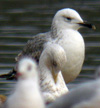
Larus cachinnans 2CY-3CY PUEX February 2011 & February 2012, France & Germany. Picture: Alain Fossé & Armin Deutsch.
From Ukraine.

Larus cachinnans 3CY PUHA February 2012, Varna, Bulgaria. Picture: Gabriel Martín.
From Ukraine.
 Larus cachinnans 3CY 53P2 February 03 2016, Barneveld, the Netherlands. Picture: Herman Bouman.
Larus cachinnans 3CY 53P2 February 03 2016, Barneveld, the Netherlands. Picture: Herman Bouman. Larus cachinnans 3CY 372P February 16 2010, Schachtschleuse - Minden, Germany (52°18'10"N, 08°55'14"E).
Picture: Armin Deutsch.
Larus cachinnans 3CY 372P February 16 2010, Schachtschleuse - Minden, Germany (52°18'10"N, 08°55'14"E).
Picture: Armin Deutsch.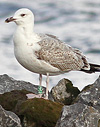 Larus cachinnans P342 2CY-3CY, July 2014 & February 2015, Rotterdam, the Netherlands. Picture: Cornelis Fokker & Merijn Loeve.
Larus cachinnans P342 2CY-3CY, July 2014 & February 2015, Rotterdam, the Netherlands. Picture: Cornelis Fokker & Merijn Loeve. Larus cachinnans P515 1CY-6CY, May 2012 - January 2017, Urszulin Lubelskie, Poland & Oss, the Netherlands.
Larus cachinnans P515 1CY-6CY, May 2012 - January 2017, Urszulin Lubelskie, Poland & Oss, the Netherlands. Larus cachinnans hybrid 2CY PLG DN-25436 July - August 2012 & February 2013, Deponie Pohlsche Heide - Minden, Germany (52°23'05N, 08°46'45E).
Picture: Armin Deutsch.
Larus cachinnans hybrid 2CY PLG DN-25436 July - August 2012 & February 2013, Deponie Pohlsche Heide - Minden, Germany (52°23'05N, 08°46'45E).
Picture: Armin Deutsch. Larus cachinnans hybrid 3cy 2L2L 18-20 February 2013, Barneveld, the Netherlands. Picture: Herman Bouman & Theo Muusse.
Larus cachinnans hybrid 3cy 2L2L 18-20 February 2013, Barneveld, the Netherlands. Picture: Herman Bouman & Theo Muusse.  Larus cachinnans 3cy, February 04 2011, Ashdod, Israel. Picture: Amir Ben Dov.
Larus cachinnans 3cy, February 04 2011, Ashdod, Israel. Picture: Amir Ben Dov. Larus cachinnans 3cy, 19 February 2012, Zagreb, Croatia. Picture: Mars Muusse.
Larus cachinnans 3cy, 19 February 2012, Zagreb, Croatia. Picture: Mars Muusse. Larus cachinnans 3cy, 19 February 2012, Zagreb, Croatia. Picture: Mars Muusse.
Larus cachinnans 3cy, 19 February 2012, Zagreb, Croatia. Picture: Mars Muusse. Larus cachinnans 3cy, 19 February 2012, Zagreb, Croatia. Picture: Chris Gibbins.
Larus cachinnans 3cy, 19 February 2012, Zagreb, Croatia. Picture: Chris Gibbins. Larus cachinnans 3cy, 19 February 2012, Zagreb, Croatia. Picture: Mars Muusse.
Larus cachinnans 3cy, 19 February 2012, Zagreb, Croatia. Picture: Mars Muusse. Larus cachinnans 3cy, 19 February 2012, Zagreb, Croatia. Picture: Mars Muusse.
Larus cachinnans 3cy, 19 February 2012, Zagreb, Croatia. Picture: Mars Muusse. Larus cachinnans 3cy, 18 February 2012, Zagreb, Croatia. Picture: Ruud Altenburg.
Larus cachinnans 3cy, 18 February 2012, Zagreb, Croatia. Picture: Ruud Altenburg.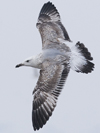 Larus cachinnans 3cy, 19 February 2012, Zagreb, Croatia. Picture: Mars Muusse.
Larus cachinnans 3cy, 19 February 2012, Zagreb, Croatia. Picture: Mars Muusse. Larus cachinnans 3cy, 19 February 2012, Zagreb, Croatia. Picture: Mars Muusse.
Larus cachinnans 3cy, 19 February 2012, Zagreb, Croatia. Picture: Mars Muusse. Larus cachinnans 3cy, 19 February 2012, Zagreb, Croatia. Picture: Mars Muusse.
Larus cachinnans 3cy, 19 February 2012, Zagreb, Croatia. Picture: Mars Muusse. Larus cachinnans 3cy, 19 February 2012, Zagreb, Croatia. Picture: Mars Muusse.
Larus cachinnans 3cy, 19 February 2012, Zagreb, Croatia. Picture: Mars Muusse.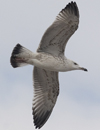 Larus cachinnans 3cy, 19 February 2012, Zagreb, Croatia. Picture: Mars Muusse.
Larus cachinnans 3cy, 19 February 2012, Zagreb, Croatia. Picture: Mars Muusse. Larus cachinnans 3cy, 19 February 2012, Zagreb, Croatia. Picture: Mars Muusse.
Larus cachinnans 3cy, 19 February 2012, Zagreb, Croatia. Picture: Mars Muusse. Larus cachinnans 3cy, 19 February 2012, Zagreb, Croatia. Picture: Mars Muusse.
Larus cachinnans 3cy, 19 February 2012, Zagreb, Croatia. Picture: Mars Muusse.

